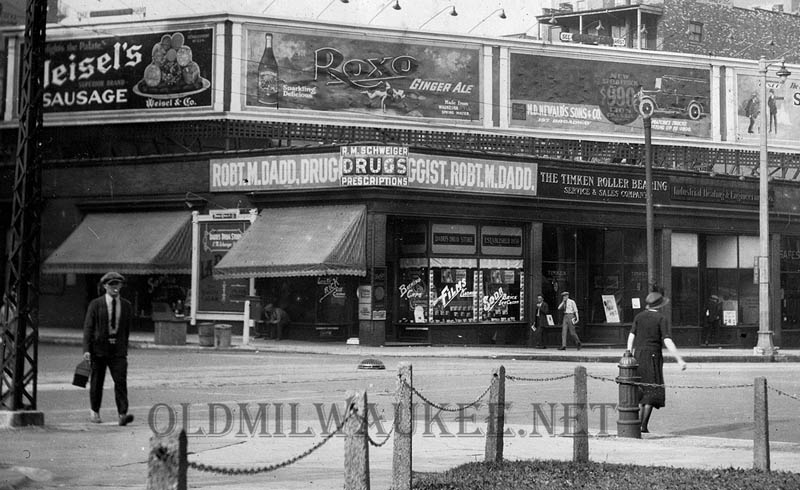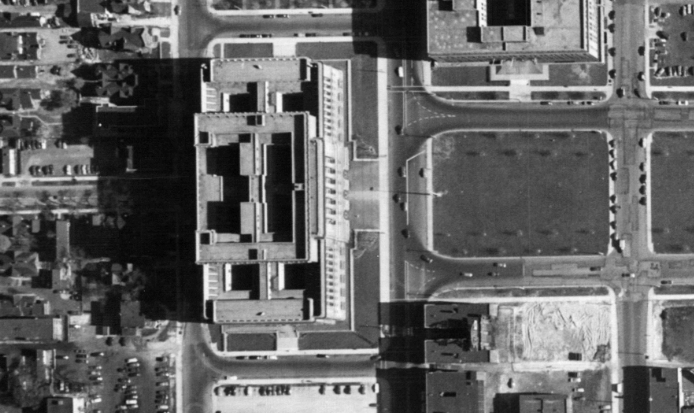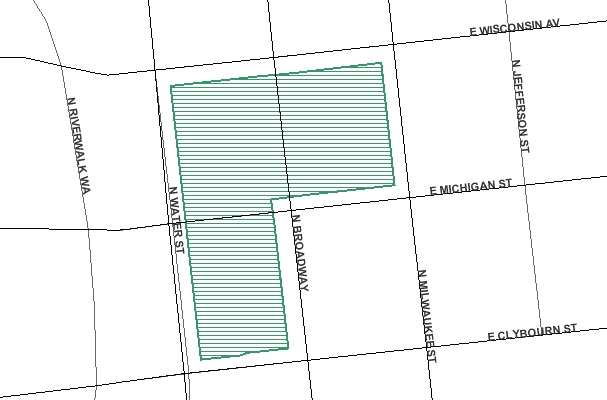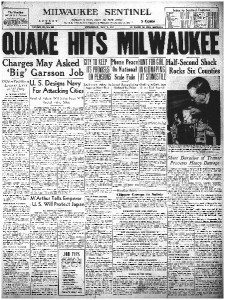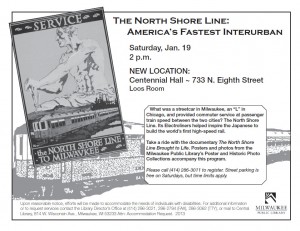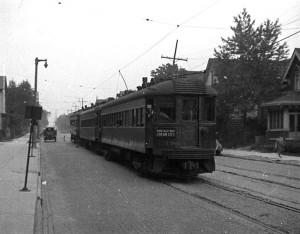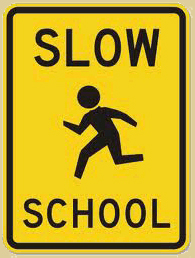This is a view looking at the corner now occupied by Taylor’s on the southwest corner of Jefferson & Wells. The picture was taken sometime in the 1920s. Back then the corner was occupied by several businesses; a drug store, roller bearing sales, and a heating company. The single story building has gone through many changes over the years but has stayed around, unlike some of the larger, neighboring buildings such as the Court-house, the Masonic Building, and even the old Layton gallery down the street at Mason.
Milwaukee County has a powerful online mapping tool which integrates a fully featured Geographic Information System, GIS. There are many layers that give useful information including historic aerial photos of the city and county going back to 1936. The 1951 aerial photo layer was completed in January which shows a highly detailed view of the entire county. Hopefully later this year an additional aerial photo set from 1928 will be included.
Also for those interested, there is up to date housing foreclosure information updated at the end of the year. As with any government GIS map, finding information on property owners is a simple click away. There is a little learning curve for people unfamiliar with using GIS maps but you cannot break it so play with it to learn.
I realize that not everyone uses Facebook but sometimes there are things you can only find there. This page is for a group called the Grand Warner Theatre Trust that is trying to resurrect the old theater on 2nd & Wisconsin. From the Facebook page:
Recently, a Trust headed by Myron Heaton was formed to explore purchasing and restoring the theatre. They met with architecture firm, contractors, representatives of the city, and potential funders of the project in December. Stay tuned for more info.
Hopefully they can get enough support to bring this ghost of the past back to life and I can encourage everyone interested in this theater to show their support. I will post more information as it appears.
The East Side Commercial Historic District: From Controversy to Catalyst
The HMI panel discussion on Thursday night, January 17th talked about many recent issues and changes that have happened in the East Side Commercial Historic District. This locally designated historic district, under the jurisdiction of the City of Milwaukee Historic Preservation Commission (HPC) is shown here:
The controversy which spawned this discussion began in 2010 with plans by Wave Development to build a new 200 room Marriott Hotel in place of five historic buildings within the district. The developers fought the HPC rejection of their initial plans. Those plans ran counter to preservation guidelines put in place for the district in 1987 as well as the Preservation Ordinance. The ensuing battle between the developer’s public relations firm, the City HPC, and preservationists became a media event for weeks. When the dust settled, the developer revised their plans to save the Noonan Block on Wisconsin Avenue. The Preservation Ordinance was subsequently put in the spotlight with promises to be gutted by Alderman Witkowski because it was viewed as anti-development. It was amended in December of 2012 by the Common Council but with changes that made it stronger and not weaker. The final consensus was that preservation “makes good economic sense”.
UWM Professor, Matt Jarosz presented the history of the district and its importance as the virtual heart of Milwaukee since the first settlement. It is unique among similar American cities in not continuously redeveloping the land as time progressed. Many of the buildings within the district are 19th century interspersed with a few early 20th century buildings examples. Professor Jarosz went on to give a multitude of examples from his students on how this district could be improved to take advantage of the current impediments. Some of the best concepts took advantage of underutilized surface parking to build modern buildings that connect to historic buildings and offer updated access to those buildings. These new buildings would add larger entrances, elevator service, and other improvements to modern standards and codes without requiring expensive retrofits to the older, historic buildings. One example showed how a new structure to the south of the Iron Block could add features to it and the Zimmermann Block next door. Infilling adjacent to the Button Block would encourage re-use of the upper floors. Another interesting proposal was converting the public alleys into shared space that could be used as a semi-covered pedestrian space or for extended outdoor seating. His common theme was that intelligent, planned new development could reinvigorate the district and encourage property owners to invest in building rehabilitation.
Some of the other presentations of the evening included an overview of the work done by architect Mark Demsky of Dental Associates with the restoration of the Iron Block Building. Dental Associates took unprecedented steps in restoring features that had been removed from the building over 100 years ago including decorative cast iron urns above the Water Street entrance and intricate grape leaves on the columns. He researched the history of renovations and found a trove of information that would be overlooked by architects doing a basic renovation. When the building is unveiled in March it should be a showpiece of preservation in Milwaukee.
Steve Schwartz, CEO of the First Hospitality Group talked about his company’s work renovating the Loyalty building on Broadway and Michigan. They faced many challenges in converting the Solomon Spencer Beman designed masterpiece from an office building into a hotel with modern conveniences. As with many 125 year-old buildings, it had been remodeled many times over the years, removing or hiding some of the notable features. The First Hospitality Group has been involved in several adaptive re-uses nationally, this building being the sixth. The first was in Indianapolis, converting a former 16-story bank building into a Hilton Garden Inn in 2003. Adaptive re-use preserves details of historic buildings that couldn’t be done economically in a new building and creates an “experiential” space encouraging participation and use.
The final talk was given by Josh Jeffers, owner of the Mitchell Building with the work he has been doing the past few years in stabilizing the foundations of his building as well as the facade and roof renovations. The persistent problem of a dropping watertable downtown have resulted in the exposure of old wooden piles under building foundations to wood rot. In the Mitchell Building, it was found that many of the footings were unsupported because of the advanced state of decay of these pilings. The exterior of the building shows some effects of the settlement over the years. The work to repair the problem has been time consuming because nearly all of the excavation has to be done by hand in tight spaces in the basement. Great care must be taken to avoid further damage to the building. The area under the stone pile caps must be removed manually, the rotted piles must be cut out and a new concrete pile cap was poured in the excavated area. In addition, a new technology of using the building’s wastewater in a sub-basement drain system was used to keep the deeper wooden piles wet and free from future rot. This major investment in the building will keep it standing firm for many years to come.
The Milwaukee Daily News in the early teens seemed to always have reporters that would cover the quirky cases of the Police Court. The reporters would delve into it and always come up some stories that were odd.
Friday, April 10, 1914
Mrs. Josephine Harczak is the proprietress of a boarding house on Middlemass avenue and up to Wednesday night Stanislaws Wajevic was the star boarder.
Stanislaws won the heart of Mrs. Harczak, who is a widow and a good cook, by praising her hash and her dead husband, and the fact that he sported a clean collar twice a week and paid his board bill promptly led the good housewife to believe that Stanislaws was a Russian nobleman in disguise.
Stanislaws ogled with Mrs. Harczak at the breakfast table, flirted with her at dinner, and he chucked her under the chin and winked at her after the supper dishes had been cleared away.
It was a romantic courtship and it lasted two weeks. It ended Monday night with a proposal of marriage.
“Will you be mine, fair one?” breathed Stanislaws into his landlady’s ear while they were seated on the sofa, “There is nothing on earth I wouldn’t do for you!”
“Oh, Stanny, this is so sudden! But it took you so long to say it.” she gushed coyly. “I am yours for keeps.”
They would be married in May, promised Stanislaws.
Tuesday night the man jumped up from the table while reading a newspaper and pointed out to his promised one an item which stated that a house a block away had been entered by thieves.
“This is bad,” he told the landlady. “They will come here next. I’ve got a gun and am prepared for ’em. Better let me take care of your valuables, Josie, and they’ll be safer.”
“Good idea.” agreed Mrs. Harczak. She turned over to her fiance $135 in cash and a number of rings.
At 11:30 o’clock Wednesday night there was a great commotion in the Harczak boarding house. Doors slammed, there was a sound of footsteps in the dark hallways and suddenly two revolver shots rang out and woke up the sleepers.
White-faced and apprehensive, the boarders peered out of their rooms.
Mrs. Harczak casually noticed that he bravely entered the hall.
She saw Stanislaws hopping in the hall in blue pajamas and a black rage. He was brandishing a gun and cussing.
“They got it, the villyins!” he howled. “Two sneak thieves got in my rooms and stole your money and jewelry. They skipped out. I shot one of the fellows in the ear but he dove through a window.”
Mrs. Harczak casually noticed that all of the doors and windows were fastened on the inside. It was queer, thought she, that the “burglars” could get in through the keyhole. Then a horrible suspicion dawned on her.
Under the pretense of making the beds, Mrs. Harczak entered the would-be husband’s room Thursday afternoon, instigating a search and found the money and rings reposing at the bottom of her boarder’s trunk. She had the man arrested.
In court Stanislaws asked for a continuance for a week. It was granted.
This one seems particularly appropriate today and may be something we should go back to?
March 13, 1914
Gustave Wiese, found guilty of carrying a concealed weapon on March 6, has been judged insane by Dr. A. F. Young, who was appointed to examine him. He has a mania for collecting revolvers. The man will be removed to the Milwaukee County Hospital for the Insane.
In all of recorded history, the Milwaukee area has been at the epicenter of an earthquake only once. This was on May 6, 1947 and luckily was only a short 4.0 magnitude quake, lasting only about 40 seconds. Although no major damage to infrastructure or buildings were reported, several downtown buildings were evacuated by frightened workers.
The sudden jolt threw the pens off of the two seismographs at the Marquette University physics department. The Rev. Joseph Carroll was at the time the head of the Physics Department at the university and it had the only seismographs in the area.
The Milwaukee Sentinel from May 7, 1947 reported:
Mayor Bohn called to see if the City Hall should be evacuated in case of another quake. Inspector Hubert Dax of the Police Department had the same question about the Safety Building.
Both were reassured by Father Carroll, who pointed out that Milwaukee “might not have another quake for 100 years.” He explained:
“The tilt of the rock of the lake shore, which probably caused the quake, will almost certainly not occur in the near future and may never occur again.”
A later quote gave a more interesting history of Wisconsin earthquakes showing how rare this event could be.
Yesterday’s quake is the only one on record in Wisconsin, Father Carroll added, and the only one even rumored in the state before the days of the seismograph was a light one in the 1750s.
Historic Milwaukee, Inc. has a few events that are coming up that may be worth your while to enjoy.
The first event is “The East Side Commercial Historic District: From Controversy to Catalyst” which will be held next Thursday, January 17th.
When: Thursday, January 17
Where: Reinhart Boerner Van Deuren s.c.
1000 North Water Street, 17th Floor
6:00-7:00pm: Networking Reception
7:00pm: Panel Discussion
Reception and Panel: $25 Non members; $20 for members
Panel Only: $10 Non members; $5 Members
Parking available for a fee: Enter the parking garage on Market Street
RSVP Required: Sign up on-line or contact HMI for tickets, 414-277-7795.
Learn about the East Side Commercial Historic District’s past, present and future from the stakeholders who are growing this important Milwaukee cornerstone. Panelists include Steve Schwartz, CEO of the First Hospitality Group with the Loyalty building; UWM Professor Matt Jarosz; Mark Demsky of Dental Associates and the Iron Block Building; Josh Jeffers, owner of the Mitchell Building; and Bruce Block, Co-Chair of Reinhart’s Real Estate Practice, as the moderator.
_________________________________________________________________
The second event is a big fundraiser on February 25th that will be held at The Grain Exchange Room in the Mackie Building. It is a little pricier but is for a great cause and is worth going to at least once in your life.
Check the HMI website for more information and to register.
There will be a presentation and video on the history of the North Shore Interurban line which ran from Milwaukee to Chicago. The event will coincide with the abandonment 50 years ago this month and will be held on Saturday, January 19th, 2:00 p.m. at Centennial Hall, 733 N. 8th St.
Please call 414-286-3011 to register. This will be a great event, as always!
Here is a sad story of how the original school zone sign came to be. This article is from a January 1921 issue of Safety Engineering magazine.
Safety Engineering, January 1921
“School, Drive Slow”How did this effective and widely prevalent traffic sign near schoolhouses originate? Who was the inventor? What led to the invention?
In October, 1914, a little boy in Milwaukee, coming out of school, saw his father waiting for him, in an automobile across the street. His father calling, “Come quick,” he ran across the street as fast as he could. Neither the father nor his little son noticed a heavy truck that was coming along at full speed. Its heavy wheels killed the boy instantly. The father’s grief was beyond description. He was a physician, a specialist for children. The boy was his only child. The unfortunate truck driver tried his best to stop but he was driving at a speed that made stopping impossible. The driver was heart-broken over the accident.
The circumstances of the distressing fatality came to the attention of Miss Emma M. Selle, a friend of little children. The thought came into her mind that signs should be placed near schoolhouses calling attention of drivers to the nearness of the school and commanding them to drive slow and look out for the children. If a sign of that kind had been placed near the school where the little boy was killed, the driver of the truck could have stopped his machine and the child’s life would have been saved.
Miss Selle wrote the pathetic story to a city official, who turned the letter over to the Safety First Committee of Milwaukee, recently organized. There was an 8-mile speed limit ordinance in force in the city and a sign giving that information had been placed near one school in the city. When Miss Selle’s letter came before the City Council, suggesting that the signs, “school, Drive Slow,” be placed in several places near each schoolhouse, money was appropriated for that purpose and the signs were erected.
On December 12, 1916, Miss Selle wrote to President Wilson, asking him to suggest to the governors of the different States, then meeting in New York, that similar signs be placed near all schoolhouses throughout the United States. On December 14, Mr. Tumulty, private secretary to the President, sent an acknowledgement of her letter and said that her suggestion would be brought to the attention of the President. On December 18 Miss Selle received a letter from the office of the Commissioners of the District of Columbia, signed by Mr. D. J. Donovan, secretary, saying that the Commissioners of the District had received her letter to President Wilson, which the President had referred to the Commissioners, and that due consideration would be given to the placing of signs in streets near schoolhouses in order to protect the children.
On December 15, 1916, Miss Selle wrote to Governor Phillips of Wisconsin telling of the accident that had happened. Through the influence of Governor Phillips, the signs, “School, Drive Slow,” were placed near every schoolhouse in the State of Wisconsin—public, parochial and even small country schools.
“school, Drive Slow,” conveys three distinct thoughts:
“School” suggests the near presence of children.
“Drive” arrests the attention of drivers.
“Slow’ is a command which makes every driver involuntarily grip his wheel to slacken his pace.
In some cases, warning signs, made up according to the ideas of city officials, had been placed near schoolhouses. But most of them were complicated, containing many words, and were either not read or not heeded.
Hence, the first real safety sign to protect school children was Miss Selle’s “School, Drive Slow,” which is now being rapidly installed everywhere throughout the United States. Other signs have been developed from the original “Drive Slow” idea, such as “Keep To The Right, Drive Slow,” seen on bridges; and “Danger, Drive Slow,” seen near sharp turns in roads.
The Wisconsin Historic Society is a great resource for online research with its collections of images, books, newspaper articles, historic buildings, etc. Now they have added online browsing to a portion of their map collection which includes several amazing old maps of Milwaukee. The Increase Lapham drawing of the city from 1836 shows all of the landholders in the town. An 1856 birdseye map will keep you occupied with the amazing detail as you zoom in.
